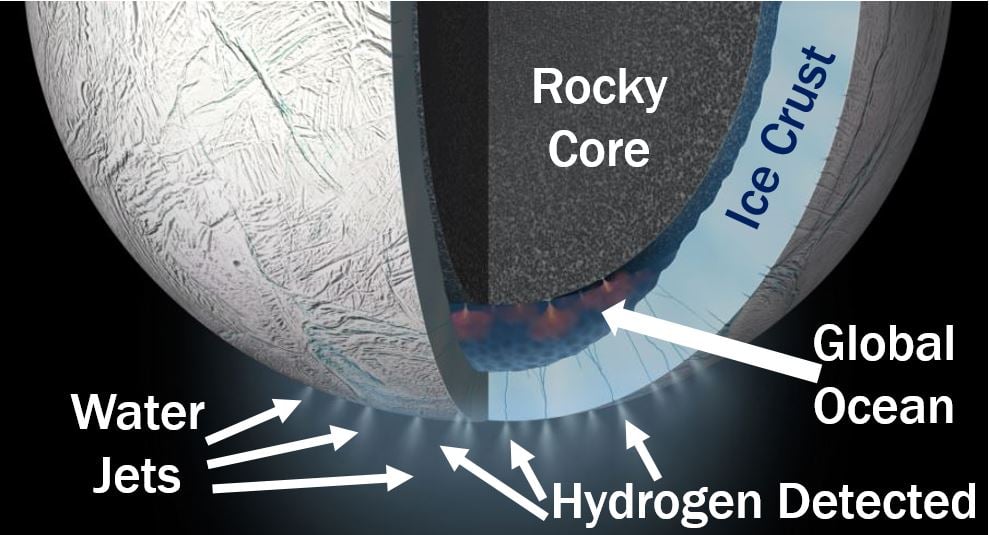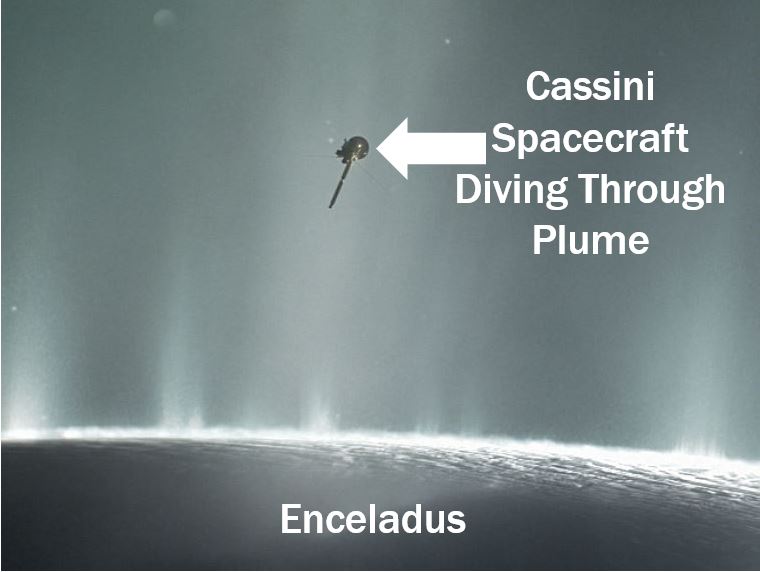Enceladus, one of the moons that orbits Saturn, probably has conditions for life – as we know it – to exist, says a team of scientists from Southwest Research Institute, San Antonio, Texas. They have discovered hydrogen gas in a plume of material erupting from the moon, which they believe is the result of chemical reactions between warm water from its subsurface ocean and its rocky core.
Principal investigator of Cassini’s Ion Neutral Mass Spectrometer (INMS), Dr. Hunter Waite, and colleagues say that their discovery suggests that the ocean floor of Enceladus could have features similar to those seen in the hydrothermal vents on Earth, which support life on the seafloor.
Cassini–Huygens (Cassini) is a Flagship-class NASA-ESA-ASI robotic spacecraft sent to the planet Saturn. As of April 2017, since it entered Saturn orbit, Cassini’s mission is ongoing – to study the planet and its many natural satellites (moons). Enceladus is Saturn’s sixth-largest moon.
 During Cassini’s deepest dive through a plume off Enceladus’ South Pole, researchers discovered hydrogen gas in the material erupting from the moon. This discovery increases the likelihood that Enceladus has the conditions for life as we know it to exist. (Image: adapted from swri.org/press)
During Cassini’s deepest dive through a plume off Enceladus’ South Pole, researchers discovered hydrogen gas in the material erupting from the moon. This discovery increases the likelihood that Enceladus has the conditions for life as we know it to exist. (Image: adapted from swri.org/press)
Dr. Waite, who was lead author of an article published in the journal Science on April 14th, 2017 – Cassini Finds Molecular Hydrogen in the Enceladus Plume: Evidence for Hydrothermal Processes – explained:
“Our results indicate the same chemical energy source is present in the ocean of Enceladus. We have not found evidence of the presence of microbial life in the ocean of Enceladus, but the discovery of hydrogen gas and the evidence for ongoing hydrothermal activity offer a tantalizing suggestion that habitable conditions could exist beneath the moon’s icy crust.”
Hydrothermal vents in Enceladus?
The hydrothermal vents on Earth’s ocean floor emit hot, mineral-laden liquid, allowing unique ecosystems – teeming with strange life forms – to thrive. Tiny microbes that convert the mineral-laden liquid into metabolic energy make these ecosystems possible.
Co-author Dr. Christopher Glein, a pioneer of extraterrestrial chemical oceanography, said regarding the quantity of hydrogen they detected:
“The amount of molecular hydrogen we detected is high enough to support microbes similar to those that live near hydrothermal vents on Earth. If similar organisms are present in Enceladus, they could ‘burn’ the hydrogen to obtain energy for chemosynthesis, which could conceivably serve as a foundation for a larger ecosystem.”
 Saturn, the sixth planet from the Sun, is the second-largest in our Solar System, after Jupiter. Enceladus is the sixth-largest moon of Saturn. Enceladus was discovered in 1789 by William Herschel (1738-1822), a British composer and astronomer of German origin.
Saturn, the sixth planet from the Sun, is the second-largest in our Solar System, after Jupiter. Enceladus is the sixth-largest moon of Saturn. Enceladus was discovered in 1789 by William Herschel (1738-1822), a British composer and astronomer of German origin.
During the space probe’s flyby of Enceladus in October 2015, INMS detected molecules of hydrogen as it flew through the plume of gas and ice grains coming out through the cracks on the surface.
Enceladus has a global ocean
Data gathered and analyzed from previous flybys suggested there was a subsurface ocean surrounding the Enceladus’ rocky core. Molecular hydrogen with the plumes could serve as a marker for hydrothermal processes, which may provide the chemical energy required to support life as we know it.
Cassini flew extremely near to Enceladus’ surface to search for hydrogen specifically native to the moon, and operated INMS in a specific mode to minimize and quantify any misleading sources.
Co-author, Rebecca Perryman, the INMS operations technical lead, said:
“We developed new operations methods for INMS for Cassini’s final flight through Enceladus’ plume. We conducted extensive simulations, data analyses, and laboratory tests to identify background sources of hydrogen, allowing us to quantify just how much molecular hydrogen was truly originating from Enceladus itself.”
The researchers also considered other possible sources of hydrogen from Enceladus itself, such as a preexisting reservoir in the global ocean or ice shell. After carrying out extensive analyses, they determined that it was unlikely that the hydrogen that was observed was acquired during Enceladus’ formation or from other processes on its surface or inside it.
 An illustration of the Cassini spacecraft diving through an Enceladus plume in 2015. (Image: nasa.gov)
An illustration of the Cassini spacecraft diving through an Enceladus plume in 2015. (Image: nasa.gov)
Dr. Waite said:
“Everything indicates that the hydrogen originates in the moon’s rocky core. We considered various ways hydrogen could leach from the rock and found that the most plausible source is ongoing hydrothermal reactions of rock containing reduced minerals and organic materials.”
In an Abstract preceding the article in the journal Science, the authors concluded:
“We find that the most plausible source of this hydrogen is ongoing hydrothermal reactions of rock containing reduced minerals and organic materials.”
“The relatively high hydrogen abundance in the plume signals thermodynamic disequilibrium that favors the formation of methane from CO2 in Enceladus’ ocean.”
Video – Does Enceladus host life?
This Science Magazine tells us about Saturn’s sixth-largest moon, Enceladus, which has a diameter of approximately 500 km.
